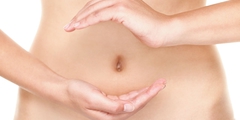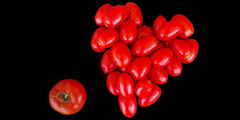
In de darmen worden talrijke gassen gemaakt. Ze ontstaan uit spontane chemische reacties en door de inwerking van bacteriën op het deel van de voeding dat niet is opgenomen in de dunne darm. Bij een typisch westerse voeding gaat het om zo’n 40 gram koolhydraat, 12-18 gram eiwit en maximaal 7 gram vet. Afhankelijk van de hoeveelheid en het type gas dat hieruit ontstaat, veroorzaken ze gunstige of ongunstig effecten.1
Beste bezoeker, u heeft geen toegang.
Enkel (web)abonnees hebben toegang tot tijdschriftartikelen. Het webabonnement is nog in de maak.
U kunt zich wel alvast (gratis) registreren en tal van andere webartikelen raadplegen!
Auteur
Verschenen in
Referenties
1. Kalantar-Zadeh K, Berean KJ, Burgell RE, et al. Intestinal gases: influence on gut disorders and the role of dietary manipulations. Nat Rev Gastroenterol Hepatol. 2019 Dec;16(12):733-747.
2. Levitt MD. Volume and composition of human intestinal gas determined by means of an intestinal washout technic. N Engl J Med. 1971 Jun 24;284(25):1394-8.
3. Sahakian AB, Jee SR, Pimentel M. Methane and the gastrointestinal tract. Dig Dis Sci. 2010 Aug;55(8):2135-43.
4. Freire R, Mego M, Oliveira LF, et al. Quantitative GC-TCD Measurements of Major Flatus Components: A Preliminary Analysis of the Diet Effect. Sensors (Basel). 2022 Jan 22;22(3):838.
4b. Hylemon PB, Harris SC, Ridlon JM. Metabolism of hydrogen gases and bile acids in the gut microbiome. FEBS Lett. 2018 Jun;592(12):2070-2082.
5. Dixon BJ, Tang J, Zhang JH. The evolution of molecular hydrogen: a noteworthy potential therapy with clinical significance. Med Gas Res. 2013 May 16;3(1):10.
6. Ohta S. Molecular hydrogen as a novel antioxidant: overview of the advantages of hydrogen for medical applications. Methods Enzymol. 2015;555:289-317.
7. Li S, Liao R, Sheng X, et al. Hydrogen Gas in Cancer Treatment. Front Oncol. 2019 Aug 6;9:696.
8. Yamamoto R, Homma K, Suzuki S, et al. Hydrogen gas distribution in organs after inhalation: Real-time monitoring of tissue hydrogen concentration in rat. Sci Rep. 2019 Feb 4;9(1):1255.
9. Shimouchi A, Nose K, Yamaguchi M, et al. Breath hydrogen produced by ingestion of commercial hydrogen water and milk. Biomark Insights. 2009 Feb 9;4:27-32.
10. Singh VV, Toskes PP. Small bowel bacterial overgrowth: presentation, diagnosis, and treatment. Curr Gastroenterol Rep. 2003 Oct;5(5):365-72.
11. Däbritz J, Mühlbauer M, Domagk D, et al. Significance of hydrogen breath tests in children with suspected carbohydrate malabsorption. BMC Pediatr. 2014 Feb 27;14:59.
12. Bures J, Cyrany J, Kohoutova D, et al. Small intestinal bacterial overgrowth syndrome. World J Gastroenterol. 2010 Jun 28;16(24):2978-90.
13. Ghoshal UC. How to interpret hydrogen breath tests. J Neurogastroenterol Motil. 2011 Jul;17(3):312-7.
14. Polag D, Leiß O, Keppler F. Age dependent breath methane in the German population. Sci Total Environ. 2014 May 15;481:582-7.
15. Mustafa AK, Gadalla MM, Snyder SH. Signaling by gasotransmitters. Sci Signal. 2009 Apr 28;2(68):re2.
16. Wang R. Gasotransmitters: growing pains and joys. Trends Biochem Sci. 2014 May;39(5):227-32.
17. Perridon BW, Leuvenink HG, Hillebrands JL, et al. The role of hydrogen sulfide in aging and age-related pathologies. Aging (Albany NY). 2016 Sep 27;8(10):2264-2289.
18. Shefa U, Yeo SG, Kim MS, et al. Role of Gasotransmitters in Oxidative Stresses, Neuroinflammation, and Neuronal Repair. Biomed Res Int. 2017;2017:1689341.
19. Wareham LK, Southam HM, Poole RK. Do nitric oxide, carbon monoxide and hydrogen sulfide really qualify as 'gasotransmitters' in bacteria? Biochem Soc Trans. 2018 Oct 19;46(5):1107-1118.
20. Hendriks KD, Maassen H, van Dijk PR, et al. Gasotransmitters in health and disease: a mitochondria-centered view. Curr Opin Pharmacol. 2019 Apr;45:87-93.
21. United States Department of labor. Occupational Safety and Health Administration. Hydrogen Sulfide; accessed 19 04 2022 https://www.osha.gov/hydrogen-sulfide/hazards
21a. Belizário JE, Faintuch J, Malpartida MG. Breath Biopsy and Discovery of Exclusive Volatile Organic Compounds for Diagnosis of Infectious Diseases. Front Cell Infect Microbiol. 2021 Jan 7;10:564194.
21b. Rondanelli M, Perdoni F, Infantino V, et al. Volatile Organic Compounds as Biomarkers of Gastrointestinal Diseases and Nutritional Status. J Anal Methods Chem. 2019 Sep 10;2019:7247802.
22. Fenske JD, Paulson SE. Human breath emissions of VOCs. J Air Waste Manag Assoc. 1999 May;49(5):594-8.
23. Probert CS. Role of faecal gas analysis for the diagnosis of IBD. Biochem Soc Trans. 2011 Aug;39(4):1079-80.
24. Plöger S, Stumpff F, Penner GB, et al. Microbial butyrate and its role for barrier function in the gastrointestinal tract. Ann N Y Acad Sci. 2012 Jul;1258:52-9.
25. Silva YP, Bernardi A, Frozza RL. The Role of Short-Chain Fatty Acids From Gut Microbiota in Gut-Brain Communication. Front Endocrinol (Lausanne). 2020 Jan 31;11:25.
26. Lee JH, Zhu J. Analyses of short-chain fatty acids and exhaled breath volatiles in dietary intervention trials for metabolic diseases. Exp Biol Med (Maywood). 2021 Apr;246(7):778-789.
27. Guo C, Huo YJ, Li Y, et al. Gut-brain axis: Focus on gut metabolites short-chain fatty acids. World J Clin Cases. 2022 Feb 26;10(6):1754-1763.
28. Baxter NT, Schmidt AW, Venkataraman A, et al. Dynamics of Human Gut Microbiota and Short-Chain Fatty Acids in Response to Dietary Interventions with Three Fermentable Fibers. mBio. 2019 Jan 29;10(1):e02566-18.
29. Portincasa P, Bonfrate L, Vacca M, et al. Gut Microbiota and Short Chain Fatty Acids: Implications in Glucose Homeostasis. Int J Mol Sci. 2022 Jan 20;23(3):1105.
30. Modesto A, Cameron NR, Varghese C, et al. Meta-Analysis of the Composition of Human Intestinal Gases. Dig Dis Sci. 2021 Oct 8.
31. Kennedy PJ, Cryan JF, Dinan TG, et al. Irritable bowel syndrome: a microbiome-gut-brain axis disorder? World J Gastroenterol. 2014 Oct 21;20(39):14105-25.
32. Major G, Pritchard S, Mu^[0-9]{1,2}. rray K, et al. Colon Hypersensitivity to Distension, Rather Than Excessive Gas Production, Produces Carbohydrate-Related Symptoms in Individuals With Irritable Bowel Syndrome. Gastroenterology. 2017 Jan;152(1):124-133.e2.
33. Stanley S, Wynne K, McGowan B, et al. Hormonal regulation of food intake. Physiol Rev. 2005 Oct;85(4):1131-58.
34. Clemmensen C, Müller TD, Woods SC, et al. Gut-Brain Cross-Talk in Metabolic Control. Cell. 2017 Feb 23;168(5):758-774.
35. Kalantar-Zadeh K, Berean KJ, Ha N. et al. A human pilot trial of ingestible electronic capsules capable of sensing different gases in the gut. Nat Electron 1, 79–87 (2018).




